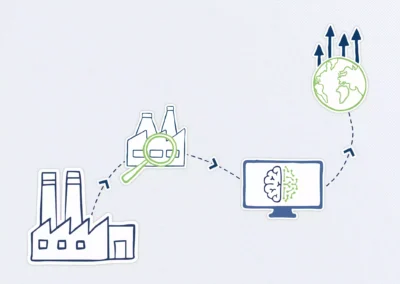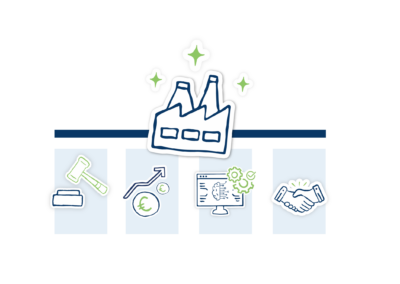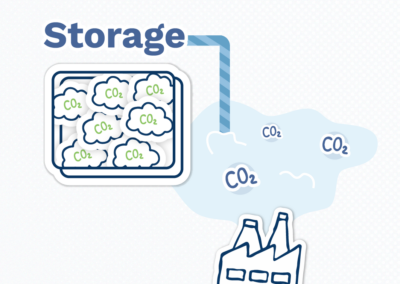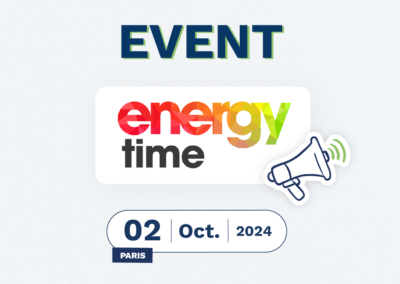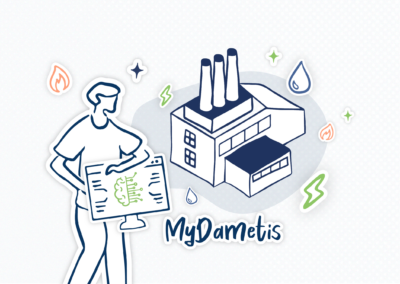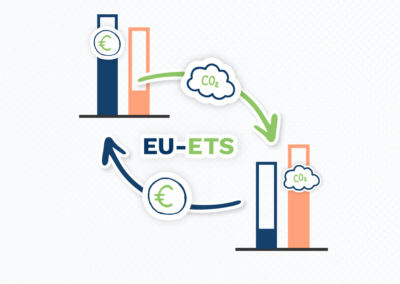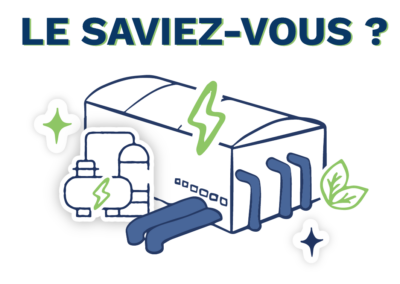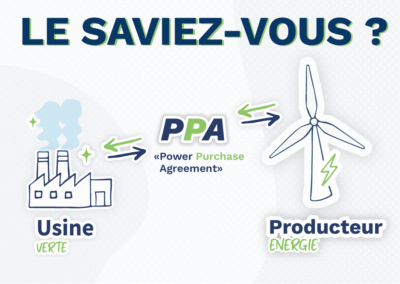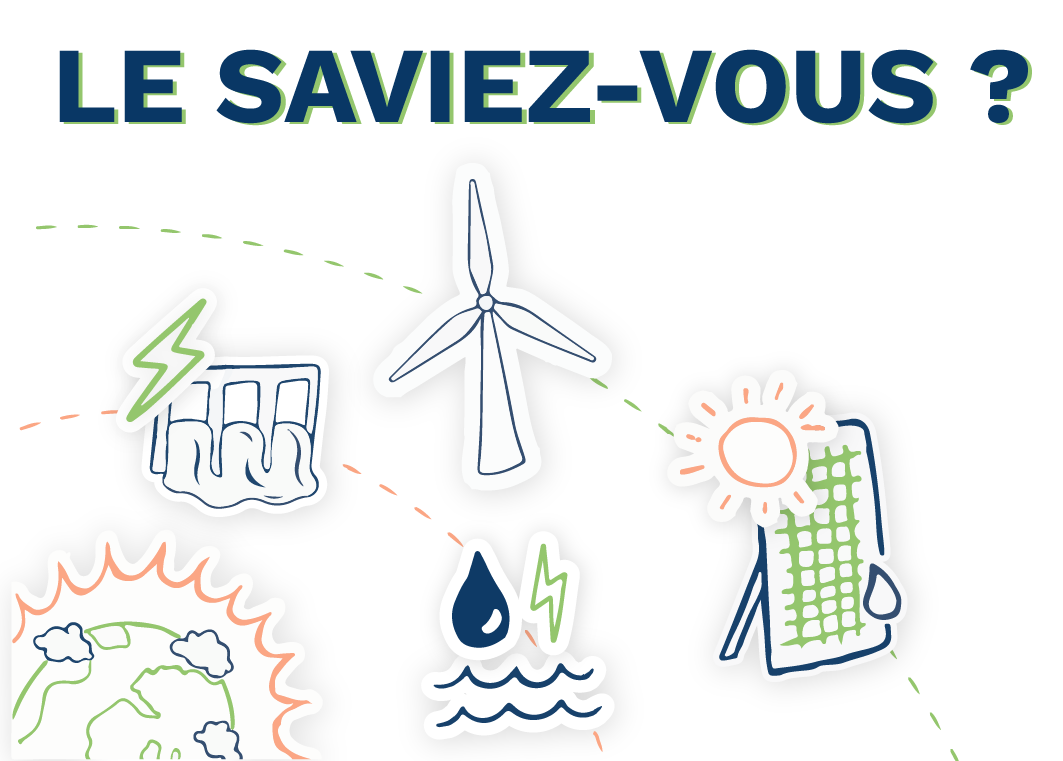
Renewable energies at the heart of the PPE 3
PPE 3: All low-carbon energy production sectors will be involved
As part of the work on the French Energy-Climate Strategy, the objectives of the next Pluriannual Energy Program, the third, known as PPE 3, were unveiled for consultation last November.
+34%
Decarbonized electricity production is expected to reach at least 640 TWh by 2035, compared with 2021.
Sources: Ministry of Energy Transition, RTE
Two main points emerge. The first is that all decarbonized energy production sectors will be called upon to contribute. Firstly, decarbonated electricity (nuclear and renewable energies), directly linked to the growing electrification of uses. Non-electricity sources (renewable heat, biofuels, etc.) will also make their contribution to decarbonizing the country.
Secondly, the objectives are ambitious. The aim is to accelerate the development of most decarbonized energy production sectors.
Triple renewable electricity production by 2035…
According to projections by the French Ministry of Energy Transition, nearly 200 TWh of additional renewable electricity (compared with 2022) will be needed by 2035, i.e. a threefold increase. This implies a sharp acceleration in the development of the main production channels.
Targets for installed capacity in renewable electrical energy

Source: French Ministry of Energy Transition
Photovoltaics is the sector upon which the strongest ambitions rely. The PPE 3 could foresee a deployment rate of at least 5.5 GW per year, aiming for 7.5 GW per year. This marks a stark acceleration since in 2022, the installed capacity for the year amounted to 2.4 GW. The government aims for this development to be balanced between ground-based farms, large rooftops, and residential areas. Agrivoltaics (photovoltaic installation on an actively farmed plot) is also being considered, with the construction of an appropriate regulatory framework Incentives for self-consumption, both for businesses and residential sectors, will be strengthened.
For onshore wind, the objective is to maintain the deployment rate at around 1.5 GW per year. However, a better territorial distribution is expected. On the other hand, PPE 3 is expected to propose a sharp acceleration in offshore wind development. Given the lead times for offshore farm commissioning, the effort will be most visible during the 2030-2035 period. Approximately 10 GW additional capacity should be allocated by 2025 through tenders to meet the objective. One of the main challenges outlined in the PPE 3 project is planning. The government aims to implement comprehensive planning for the various maritime fronts.
Finally, hydroelectric installed capacity is expected to slightly increase, especially in existing installations, as the potential for new infrastructure is limited. One measure under consideration is to promote the renovation of small hydroelectric plants.
…supporting the country’s industrialization
For the government, the development of decarbonized energy production presents an opportunity to increase the country’s industrial capabilities by locating or relocating the production of equipment necessary for the energy transition. Among the identified sectors are solar (especially the manufacturing of photovoltaic panels), wind (manufacturing various components of wind turbines), heat pumps, and electricity networks.
The offshore wind pact
March 2022, the French government and the offshore wind energy industry signed a pact with mutual commitments. In particular, the French government has announced a target of 18 GW by 2035, which is included in the draft PPE 3. For its part, the industry has pledged to invest more than 40 billion euros over 15 years, and to achieve a local content of 50% calculated on the share of costs for each project.
The modus operandi should take the form of an industry pact, along the lines of that for offshore wind power, drawing in particular on the possibilities offered by the Net-Zero Industry Act. This European regulation, adopted in 2023, aims to facilitate and promote the development of a European energy transition industry, in particular via calls for tender to benefit from financial support mechanisms. The France 2030 plan will also be used to support innovation and structure industrial sectors.
The issue of securing supplies of critical metals (lithium, cobalt, rare earths, copper, etc.) to enable the manufacturing of equipment for the energy transition will be addressed by PPE 3. The stated objective is to control their value chain, from extraction to recycling. Several levers will be (or will continue to be) utilized in these areas, including the Critical Metals of France 2030 projects and the green industries tax credit. To assess the mineral wealth of our subsoil, an exploration campaign will be launched in 2024.
Finally, training has not been forgotten. The State, the Regions and the sectors will have to work together to define needs and set up a framework for skills development.
Double renewable heat consumption
Renewable heat production targets
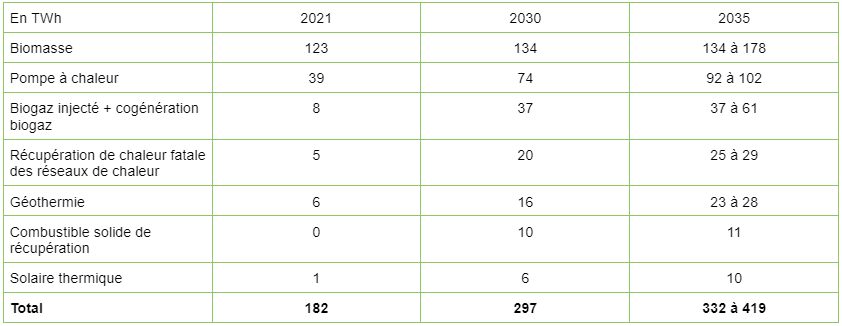
Source: French Ministry of Energy Transition
The PPE 3 forecasts a leap in heat consumption from a wide range of production sources. Biomass, heat pumps and biogas are expected to drive growth in renewable heat production. Geothermal energy, solar thermal energy and the recovery of waste heat from heating networks will also play a role.
In addition to these volumes, heating and cooling networks are set to grow significantly, as the government is aiming for 4.5 to 5.2 million additional homes to be connected by 2035 (compared with less than 1.3 million in 2020). What’s more, an increasing proportion of their production will have to come from renewable energy sources (80% by 2035, i.e. 90 TWh, compared with just over 60% at present, i.e. around 20 TWh).
Particular attention will also be paid to the recovery of industrial and tertiary waste heat. The PPE 3 plans to require a study of the recovery potential for all existing industrial units over 10 MW and new ones over 5 MW.
+225 M€
Increase the Heat Fund budget to €820 million by 2024.
Source: French Ministry of Energy Transition
Three existing support schemes are designed to help achieve these objectives. For private customers, there is MaPrimeRénov’, dedicated to financing energy renovation projects. The Fonds chaleur (heat fund) finances renewable heat production projects in various sectors (collective housing, tertiary sector, agriculture and industry). By way of example, a biomass-based project in the industrial sector with a heat output of 1.2 to 12 GWh per year may be eligible for assistance from the Heat Fund.
Finally, the decarbonization component of the France 2030 plan can be mobilized by the industrial sector in the field of renewable heat.
Moving from advanced biofuels to synthetic fuels
PPE 3 could set out a two-stage roadmap. In the short term, the aim is to develop the production of so-called advanced biofuels, derived from resources that do not compete with food (residues, waste or co-products). These advanced biofuels will complement first-generation biofuels derived from agricultural resources that can be used for food.
In the longer term, the electrification of light mobility will enable its decarbonization. For heavy mobility (air transport, shipping, fishing, etc.), biofuels and synthetic fuels (e-gasoline, e-kerosene, etc.), as well as hydrogen, are the solutions under consideration. Hydrogen, in fact, will be the subject of our next article, to find out all about France’s hydrogen strategy.










